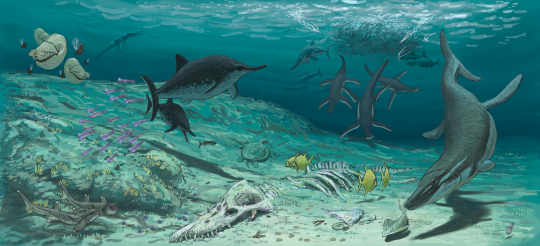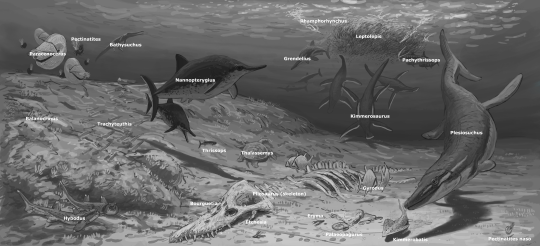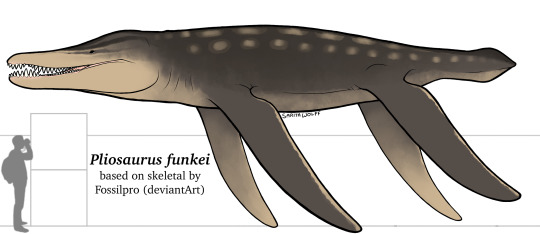#nannopterygius
Explore tagged Tumblr posts
Text


Result from the Kimmeridge Clay #paleostream!
We were only able to scratch the surface, but I think you get the idea ;)
#sciart#paleoart#paleostream#palaeoblr#jurassic#kimmeridge clay#pliosaurus#plesiosaur#plesiosuchus#nannopterygius#kimmerosaurus#sea#britain
596 notes
·
View notes
Text

"Pair of Upper Jurassic Ichthyosaurs of the genus Nannopterygius courting. These animals had small, paddle-like limbs."
Prehistoric Sea Monsters. Written by Dr. Josef Augusta. Illustrated by Zdeněk Burian. 1966.
Internet Archive
424 notes
·
View notes
Text

Patreon request for rome.and.stuff (Instagram), and my first plesiosaur (well, first since I was like… 10)
Pliosaurus funkei!
Pliosaurs were a family of plesiosaurs that eventually lost their stereotypical long-necked, small-headed body plan. Resembling the mosasaurs that would come much later, pliosaurs had short necks with large, strong jaws, and fed on fish, cephalopods, and marine reptiles. The type genus, Pliosaurus, contains at least 6 species. The first and type species, P. brachydeirus, was described and named by Sir Richard Owen in 1841.
Between 2004 and 2012, a new species of Pliosaurus was in the process of being uncovered. Before it was formally described or even named, news of this giant sea monster escaped into the general media and it was dubbed “Predator X”.
This Predator X prompted a media frenzy… there were articles estimating its size based on the fragments found so far, a 2009 television special on the History channel, and a segment in the 2011 BBC documentary series “Planet Dinosaur.”
Predator X was reportedly the “most fearsome animal ever to swim in the oceans!”

When Pliosaurus funkei was finally formally described and named in 2012, it was found to be a bit smaller than the giant 15 meter long estimate being thrown around. However, it was still a very large animal, around 10–12 m (33–39 ft) long with a 2.0–2.5 m (6.6–8.2 ft) long skull. It also had very long flippers, probably to aid in maneuverability and speed. Analysis of Pliosaurus funkei’s skeleton show that it likely used its front flippers to cruise, only using its back flippers for quick bursts of speed when pursuing prey. Analysis of its brain case shows that its brain was proportional to that of a modern great white shark. So while it didn’t quite beat the Late Cretaceous 12–15.8 meter (39–52 ft) long mosasaur Tylosaurus, the Early Miocene to Late Pliocene 10.5-20.3 meter (34-67 ft) long shark Otodus megalodon, or even the modern day 11-16 meter (36-52 ft) long Physeter macrocephalus (Sperm Whale), it was still no doubt the apex predator of its time and environment.
Pliosaurus funkei lived in the last era of the Late Jurassic in the icy waters of Norway. Found in the Slottsmøya Member of the Agardhfjellet Formation, it would have lived in a cold, shallow sea rife with methane seeps. These methane seeps supported a high amount of diversity, and the Slottsmøya was teeming with ammonites, bivalves, gastropods, brachiopods, tubeworms, echinoderms, cold water sponges, and more. Many icthyosaurs and plesiosaurs would have enjoyed feeding on the plentiful invertebrates here, as well as each other. Pliosaurus funkei would have likely fed on other plesiosaurs like Colymbosaurus, Djupedalia, Ophthalmothule, and Spitrasaurus, as well as icthyosaurs like Cryopterygius, Undorosaurus, Arthropterygius, Nannopterygius, and Brachypterygius.
#my art#SaritaDrawsPalaeo#Pliosaurus funkei#Pliosaurus#pliosaur#predator x#plesiosaurs#sauropterygians#reptiles
83 notes
·
View notes
Photo




Prehistoric Animals and Plants
by Josef Beneš illustrated by Zdeněk Burian 1979
Nannopterygius entheciodon (Reptiles of the Mesozoic seas)
Rhamphorhynchus gemmingi (Reptiles conquer the air)
Triconodon mordax (The first mammals)
Andrias scheuchzeri (Tertiary amphibians and reptiles)
#prehistoric animals and plants#nannopterygius#rhamphorhynchus#triconodon#andrias#ichthyosaurs#pterosaurs#mammals#amphibians#not dinosaurs#books
124 notes
·
View notes
Text

Zdeněk Burian (Czech, 1905-1981) - Nannopterygius (1962)
1K notes
·
View notes
Text
Un "bastone da selfie" e l'indagine scientifica rivelano un rettile marino estinto
Un “bastone da selfie” e l’indagine scientifica rivelano un rettile marino estinto

Una ricostruzione artistica del Nannopterygius in vita.
Un paleontologo russo in visita al Museo di Storia Naturale di Londra voleva disperatamente vedere lo scheletro di un rettile acquatico estinto, ma la sua teca di vetro era troppo in alto nel muro. Così ha attaccato la sua macchina fotografica digitale a un bastone da selfie, con diversi clic, ne ha annusata una grossa,…
View On WordPress
0 notes
Text

Dinosaurs. Written by Rupert Oliver. Illustrated by Bernard Long. 1983.
164 notes
·
View notes